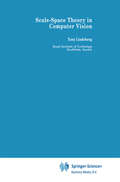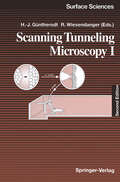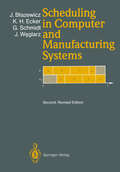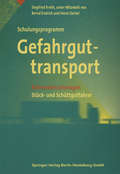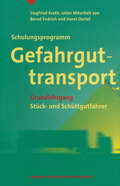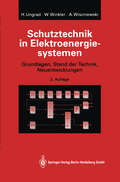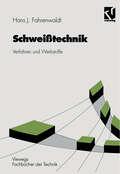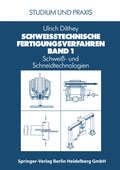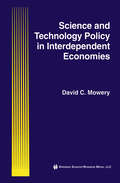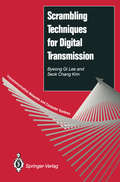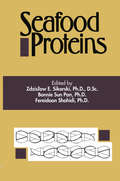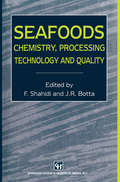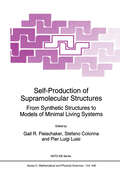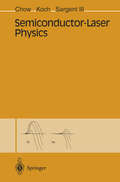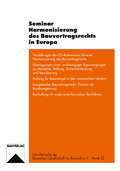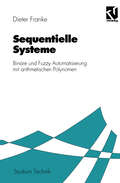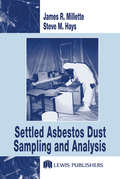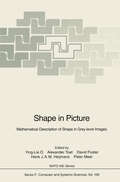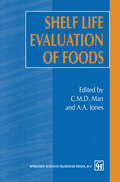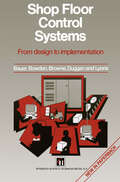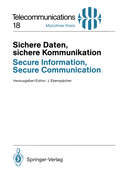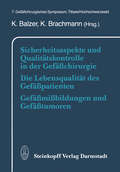- Table View
- List View
Scale-Space Theory in Computer Vision (The Springer International Series in Engineering and Computer Science #256)
by Tony LindebergThe problem of scale pervades both the natural sciences and the vi sual arts. The earliest scientific discussions concentrate on visual per ception (much like today!) and occur in Euclid's (c. 300 B. C. ) Optics and Lucretius' (c. 100-55 B. C. ) On the Nature of the Universe. A very clear account in the spirit of modern "scale-space theory" is presented by Boscovitz (in 1758), with wide ranging applications to mathemat ics, physics and geography. Early applications occur in the cartographic problem of "generalization", the central idea being that a map in order to be useful has to be a "generalized" (coarse grained) representation of the actual terrain (Miller and Voskuil 1964). Broadening the scope asks for progressive summarizing. Very much the same problem occurs in the (realistic) artistic rendering of scenes. Artistic generalization has been analyzed in surprising detail by John Ruskin (in his Modern Painters), who even describes some of the more intricate generic "scale-space sin gularities" in detail: Where the ancients considered only the merging of blobs under blurring, Ruskin discusses the case where a blob splits off another one when the resolution is decreased, a case that has given rise to confusion even in the modern literature.
Scanning Tunneling Microscopy I: General Principles and Applications to Clean and Absorbate-Covered Surfaces (Springer Series in Surface Sciences #20)
by D. Anselmetti R. J. Behm P.J.M. van Bentum S. Chiang Hans-Joachim Güntherodt R. J. Hamers H. J. Hug H. Van Kempen Y. Kuk H. Rohrer Roland Wiesendanger J. WintterlinSince the first edition of "Scanning 'funneling Microscopy I" has been pub lished, considerable progress has been made in the application of STM to the various classes of materials treated in this volume, most notably in the field of adsorbates and molecular systems. An update of the most recent develop ments will be given in an additional Chapter 9. The editors would like to thank all the contributors who have supplied up dating material, and those who have provided us with suggestions for further improvements. We also thank Springer-Verlag for the decision to publish this second edition in paperback, thereby making this book affordable for an even wider circle of readers. Hamburg, July 1994 R. Wiesendanger Preface to the First Edition Since its invention in 1981 by G. Binnig, H. Rohrer and coworkers at the IBM Zurich Research Laboratory, scanning tunneling microscopy (STM) has devel oped into an invaluable surface analytical technique allowing the investigation of real-space surface structures at the atomic level. The conceptual simplicity of the STM technique is startling: bringing a sharp needle to within a few Angstroms of the surface of a conducting sample and using the tunneling cur rent, which flows on application of a bias voltage, to sense the atomic and elec tronic surface structure with atomic resolution! Prior to 1981 considerable scepticism existed as to the practicability of this approach.
Scheduling in Computer and Manufacturing Systems
by Jacek Blazewicz Klaus H. Ecker Günter Schmidt Jan WeglarzA theoretical and application-oriented analysis of deterministic scheduling problems arising in computer and manufacturing environments. The important classical results are surveyed with particular attention paid to single-processor scheduling, along with general models such as resource-constrained scheduling, flexible flow shops, dynamic job shops, and special flexible manufacturing systems. Polynomial and exponential-time optimization algorithms as well as approximation and heuristic ones are presented using a Pascal-like notation, before being discussed in the light of particular problems. Basic concepts from scheduling theory and related fields are described to assist less advanced readers.
Schulungsprogramm Gefahrguttransport: Referentenunterlagen Stück- und Schüttgutfahrer
by Dr. Ing. KrethDas Schulungsprogramm Gefahrgut-Transport des Springer-Verlags zeichnet sich durch die besondere didaktische Darstellung aus. Es ist damit das erste Programm, das den Bedürfnissen der Zielgruppe Kraftfahrer durch die Formulierung der schwierigen Materie entgegenkommt. Die Ausbildungsunterlagen (= Folien) sind graphisch übersichtlich gestaltet und erlauben in der beschränkten Zeit des Kurses die wesentlichen Inhalte zur Erlangung der Sachkunde zu vermitteln. Diese Inhalte sind im Kursteilnehmerbuch als "Merksätze" zusammengefaßt. Die Lerninhalte entsprechen dem Rahmenlehrplan für die Gefahrgutfahrerschulung des DIHT. Der Autor und seine Mitarbeiter bilden seit vielen Jahren Fahrer aus.
Schulungsprogramm Gefahrguttransport: Fortbildungslehrgang Stück- und Schüttgutfahrer
by Siegfried KrethDas Schulungsprogramm Gefahrguttransport des Springer-Verlags zeichnet sich durch die besondere didaktische Darstellung aus. Es ist damit das erste Programm, das den Bedürfnissen der Zielgruppe Kraftfahrer durch die Formulierung der schwierigen Materie entgegenkommt. Die Lerninhalte entsprechen dem Rahmenlehrplan für die Gefahrgutfahrerschulung des DIHT. Der Autor und seine Mitarbeiter bilden seit vielen Jahren Fahrer aus.
Schutztechnik in Elektroenergiesystemen: Grundlagen, Stand der Technik, Neuentwicklungen
by Helmut Ungrad Willibald Winkler Andrzej WiszniewskiSchweißtechnische Fertigungsverfahren: Schweiß- und Schneidtechnologien (VDI-Buch)
by Ulrich DiltheyDas Buch will sowohl dem Studierenden der Fertigungstechnik als auch dem Ingenieur aus der Praxis einen Überblick über die Vielzahl der Schweiß- und Schneidtechnologien, ihre Funktionsweisen, die benötigten Einrichtungen und ihre Einsatzgebiete geben. Dabei werden sowohl die klassischen, in der industriellen Praxis eingeführten Technologien als auch die neuen Technologien beschrieben, die zur Zeit zwischen Labor und industrieller Anwendung stehen.
Science and Technology Policy in Interdependent Economies
by David C. MoweryEconomic policy debates have devoted increasing attention to the design and implementation of policies to aid the growth of high-technology firms and industries. In the United States this focus on `technology policy' has been influenced by similar debates and policy experiments in other industrial economies, notably Japan and Western Europe. The domestic U.S. debate over support for technology development and national competitiveness has been hampered by two major conceptual flaws -- the demand for immediate economic results from basic research and considering national technology policies independent of developments in the international economy. This volume addresses these deficiencies in the analysis of technology policy by examining a number of issues faced by managers and public officials in industrial and industrializing economies that are now linked closely through international flows of goods, capital, and technology. The book lays out an analytical framework for the study of national policies towards technology and science. In addition, the book addresses the complex issues raised by interdependence among the public and private institutions governing the creation, commercialization, and adoption of new technology in different national economies. Finally, the book reviews the development of two global high-technology industries: aerospace and semiconductor components.
Scrambling Techniques for Digital Transmission (Telecommunication Networks and Computer Systems)
by Byeong G. Lee Seok C. KimScramblers and shift register generators (SRG) have been used for decades in the shaping of digital transmission signals and in generating pseudo-random binary sequences for transmission applications. In recent years more attention has been paid to this area than ever before due to the change of today's telecommunication environment. This publication presents the theory and applications of three scrambling techniques - Frame Synchronous Scrambling (FSS), Distributed Sample Scrambling (DSS) and Self Synchronous Scrambling (SSS) with an emphasis on their application in digital transmission. Based on the authors' research over the past ten years, this is the first book of its kind.
Seafood Proteins
by Z. SikorskiFish and marine invertebrates are important sources of nutrients for the world's population, and many species have exceptionally high market value because of their exquisite sensory properties. Both the utilization of the available catch in different forms and the market price are affected by the quality of the fish. Proteins and nonprotein nitroge nous compounds playa crucial role in the nutritional value and sensory quality of seafoods as well as in the suitability of different species to various forms of processing, preservation, and use in other branches of the food industry. This role of proteins results from their basic chemical and biochemical properties and functions in different tissues. A presenta tion of the actual state of knowledge on seafood nitrogenous compounds in one volume may contribute to a better understanding of the involve ment of these components in all stages of handling and processing fish. It has been possible to prepare this text thanks to the cooperative effort of an international group of specialists. The editors of the book are greatly indebted to all colleagues who have willingly contributed to this volume, sharing their knowledge and experience, as well as to all persons who have granted permission to use their previously published materials. viii Preface ix A large part of the book has been prepared during my sabbatical in the Department of Marine Food Science, National Taiwan Ocean University (NTOU) in Keelung, Taiwan.
Seafoods: Chemistry, Processing Technology and Quality
by Fereidoon Shahidi J.R. BottaSeafoods are important sources of nutrients for humans. Proteins and non protein nitrogenous compounds play an important role in the nutritional value and sensory quality of seafoods. Consumption of fish and marine oils is also actively encouraged for the prevention and treatment of cardio vascular diseases and rheumatoid arthritis. Highly unsaturated long-chain omega-3 fatty acids are regarded as the active components of marine oils and seafood lipids. The basic chemical and biochemical properties of seafood proteins and lipids, in addition to flavour-active components, their microbiological safety and freshness quality, are important factors to be considered. A presentation of the state-of-the-art research results on seafoods with respect to their chemistry, processing technology and quality in one volume was made possible by cooperative efforts ofan international group of experts. Following a brief overview, the book is divided into three sections. In Part 1 (chapters 2 to 8) the chemistry of seafood components such as proteins, lipids, flavorants (together with their properties and nutritional significance) is discussed. Part 2 (chapters 9 to 13) describes the quality of seafoods with respect to their freshness, preservation, micro biological safety and sensory attributes. The final section of the book (chapters 14 to 16) summarizes further processing of raw material, underutilized species and processing discards for production of value added products.
Self-Production of Supramolecular Structures: From Synthetic Structures to Models of Minimal Living Systems (Nato Science Series C: #446)
by Gail R. Fleischaker S. Colonna Pier Luigi LuisiHow did life begin on the Earth? The units of life are cells, which can be defined as bounded systems of molecules that capture energy and nutrients from the environment -- systems that expand, reproduce, and evolve over time, often into more complex systems. This book is the proceedings of a unique meeting, sponsored by NATO and held in Maratea, Italy, that brought together for the first time an international group of investigators who share an interest in how molecules self-assemble into supramolecular structures, and how those structures may have contributed to the origin of life. The book is written at a moderately technical level, appropriate for use by researchers and by students in upper-level undergraduate and graduate courses in biochemistry and molecular biology. The overall interest of its subject matter provides an excellent introduction for students who wish to understand how the foundational knowledge of chemistry and physics can be applied to one of the most fundamental questions now facing the scientific community. The editors are pioneers in defining what we mean by the living state, particularly the manner in which simple molecular systems can assume complex associations and functions, including the ability to reproduce. Each chapter of the book presents an up-to-date report of highly significant research. Two of the authors received medals from the National Academy of Science USA in 1994, and other research reported in the book has been featured in internationally recognized journals such Scientific American, Time, and Discover.
Semiconductor-Laser Physics
by Weng W. Chow Stephan W. Koch Murray III SargentSemiconductor-Laser Physics discusses the underlying physics and operational principles of semiconductor lasers. The optical and electronic properties of the semiconductor medium are analyzed in detail, including quantum confinement and gain engineering effects. A semiclassical and a quantum version of the laser theory are presented, including an analysis of single- and multimode operation, instabilities, laser arrays, unstable resonators, and microcavity lasers.
Seminar Harmonisierung des Bauvertragsrechts in Europa (Schriftenreihe der Deutschen Gesellschaft für Baurecht e.V. #22)
by Jörg Wenzel Ulrich Paetzold Bertrand Fabre Edwin Frietsch Christian WiegandtDie Harmonisierung bzw. "Europäisierung" von Gesetzen und Verordnungen auf dem Gebiet des Bauvertragsrechts führt zu zahlreichen Änderungen gewohnter Regelungen und sorgt damit für Unsicherheit bei den Betroffenen. Dies war Anlaß für die Deutsche Gesellschaft für Baurecht e.V., ein Seminar zu veranstalten, das die Verpflichtungen, die den EG-Mitgliedstaaten in diesem Bereich zur Verwirklichung des europäischen Binnenmarktes auferlegt sind, behandelte. Alle Beiträge werden in diesem Sammelband veröffentlicht.
Sequentielle Systeme: Binäre und Fuzzy Automatisierung mit arithmetischen Polynomen
by Dieter FrankeSettled Asbestos Dust Sampling and Analysis
by Steve M. Hays James R. MilletteSettled Asbestos Dust Sampling and Analysis compiles the most significant data on asbestos in settled dust. This ready reference presents an analysis of settled dusts and surface particles of all sizes for asbestosthat is useful for qualitative and quantitative assessment and helps to determine the source of fibers. The main scope of this reference includes sample collection, sample analyses, and interpretation of settled dust data, as well as the use of such data for purposes including asbestos abatement projects and in-place management programs. Sections on lead and other particulates are also included.
Settled Asbestos Dust Sampling and Analysis
by Steve M. Hays James R. MilletteSettled Asbestos Dust Sampling and Analysis compiles the most significant data on asbestos in settled dust. This ready reference presents an analysis of settled dusts and surface particles of all sizes for asbestosthat is useful for qualitative and quantitative assessment and helps to determine the source of fibers. The main scope of this reference includes sample collection, sample analyses, and interpretation of settled dust data, as well as the use of such data for purposes including asbestos abatement projects and in-place management programs. Sections on lead and other particulates are also included.
Shape in Picture: Mathematical Description of Shape in Grey-level Images (NATO ASI Subseries F: #126)
by Ying-Lie O Alexander Toet David Foster Henk J. A M. Heijmans Peter MeerThe fields of image analysis, computer vision, and artificial intelligence all make use of descriptions of shape in grey-level images. Most existing algorithms for the automatic recognition and classification of particular shapes have been devel oped for specific purposes, with the result that these methods are often restricted in their application. The use of advanced and theoretically well-founded math ematical methods should lead to the construction of robust shape descriptors having more general application. Shape description can be regarded as a meeting point of vision research, mathematics, computing science, and the application fields of image analy sis, computer vision, and artificial intelligence. The NATO Advanced Research Workshop "Shape in Picture" was organised with a twofold objective: first, it should provide all participants with an overview of relevant developments in these different disciplines; second, it should stimulate researchers to exchange original results and ideas across the boundaries of these disciplines. This book comprises a widely drawn selection of papers presented at the workshop, and many contributions have been revised to reflect further progress in the field. The focus of this collection is on mathematical approaches to the construction of shape descriptions from grey-level images. The book is divided into five parts, each devoted to a different discipline. Each part contains papers that have tutorial sections; these are intended to assist the reader in becoming acquainted with the variety of approaches to the problem.
Shelf Life Evaluation of Foods
by A. A. Jones C. M. D.ManThe subject of shelf life of foods is not a new one. Increasing consumer interest in food safety, quality and date marking, competitjve pressures from retailers and extensive legislative changes, however, have combined to give the subject a new significance. The proper and correct determina tion of shelf life is of course fundamental to Good Manufacturing Practice (GMP) for the food and drink industry. Manufacturers who aim to produce safe, wholesome and attractive food products 'right the first time' and 'right every time' will already know the importance of proper shelf life evaluation. Incorrect shelf lives can potentially bring about dire legal, safety or financial consequences. This is not to belittle the difficulty of failing to meet consumer expectations consistently as a result of shelf lives that have been arrived at unreliably. A proper evaluation of shelf life must be grounded on sound scientific principles, supported by up-to-date techniques in food science and tech nology. This book, therefore, begins with five chapters reviewing the prin ciples of shelf life evaluation. These are followed by ten chapters on a number of selected food products. All the authors either have first hand experience on the practice of shelf life evaluation or are involved in research of the subject. Because of the diversity and complexity of food products now available, no attempt has been made to cover every product group, let alone every product conceivable.
Shop Floor Control Systems: From design to implementation
by A. Bauer J. Browne R. Bowden J. DugganIn recent years there has been a tremendous upsurge of interest in manufac turing systems design and analysis. Large industrial companies have realized that their manufacturing facilities can be a source of tremendous opportunity if managed well or a huge corporate liability if managed poorly. In particular industrial managers have realized the potential of well designed and installed production planning and control systems. Manufacturing, in an environment of short product life cycles and increasing product diversity, looks to tech niques such as manufacturing resource planning, Just In Time (lIT) and total quality control among others to meet the challenge. Customers are demanding high quality products and very fast turn around on orders. Manufacturing personnel are aware of the lead time from receipt of order to delivery of completed orders at the customer's premises. It is clear that this production lead time is, for the majority of manufacturing firms, greatly in excess of the actual processing or manufacturing time. There are many reasons for this, among them poor coordination between the sales and manufacturing function. Some are within the control of the manufacturing function. Others are not.
Sichere Daten, sichere Kommunikation / Secure Information, Secure Communication: Datenschutz und Datensicherheit in Telekommunikations- und Informationssystemen / Privacy and Information Security in Communication and Information Systems (Telecommunications #18)
by Jörg EberspächerIm geschäftlichen wie im privaten Bereich werden in wachsendem Maße Informationen und Daten aller Art freizügig ausgetauscht, verarbeitet und gespeichert. Unterstützt wird diese Entwicklung durch das immer dichter und leistungsfähiger werdende Netz der Telekommunikation. Wo hat der freie Zugang zu Daten seine Grenzen? Was ist schützenswert und wie funktionieren die Schutzmechanismen? Wie sicher sind die Informations- und Kommunikationssysteme und deren Daten? Solche für die Informationsgesellschaft wichtigen Fragen und Probleme hat der "Münchner Kreis" aus verschiedenen technischen, wirtschaftlichen, juristischen und politischen Perspektiven beleuchtet und die Risiken ebenso wie die Chanchen diskutiert und bewertet.
Sicherheitsaspekte und Qualitätskontrolle in der Gefäßchirurgie Die Lebensqualität des Gefäßpatienten Gefäßmißbildungen und Gefäßtumoren: 7. Gefäßchirurgisches Symposium, Titisee/Hochschwarzwald
by K. Balzer K. BrachmannLebensqualität und Qualitätskontrolle sind Themen, die heute in der öffentlichen Diskussion stehen. Zunehmend wird diese Diskussion von anderen Disziplinen in die Chirurgie hineingetragen. Deshalb melden sich in diesem Buch Chirurgen mit sorgfältigen eigenen Analysen spezieller Risiken und operativer Möglichkeiten zu Wort.Ihr Buch regt dazu an, über die Qualität der chirurgischen Arbeit und die Lebensqualität des Patienten neu nachzudenken und zu entscheiden, was in der Gefäßchirurgie als Standard zu gelten hat.
